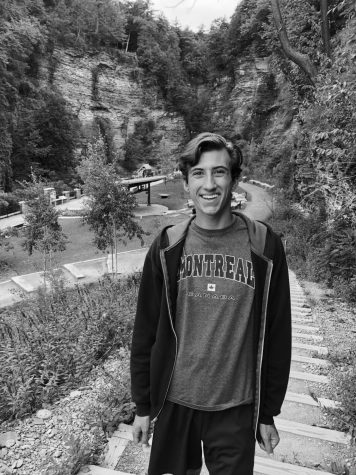We Can Change the World: Mr. Lamagna Encourages Students to Take the Initiative on Environmental Science
Mr. LaMagna’s courses emphasize the importance of maintaining an open mind and learning about human impact — integral instruments for initiating the change needed to save our planet.
February 22, 2021
Sick of textbook reading and note taking? Looking for a fun elective to fill your off period or study hall? Determined to fight the current environmental crisis?
In the fall of 2021, a new elective is joining the current listing of science courses available to Northport High School students. In Mr. David LaMagna’s Long Island Native Ecology and Plant Science course, students will gain an awareness of their local ecology and learn the benefits of — and how to grow — native plants.
The idea for the Long Island Native Ecology and Plant Science course came from Mr. LaMagna’s desire for “a more localized course where kids can have a hands on experience and learn things that they are interested in, without having to follow a textbook”. Mr. LaMagna also drew inspiration from Douglas W. Tallamy’s Nature’s Best Hope, which “provides a common sense approach” to environmental progress. “Being environmentally minded doesn’t mean saying no — it’s about pushing forward, not going backwards,” Mr. LaMagna says. “People have land and people plant stuff on their land, so why don’t we just plant stuff that is supposed to be on that land?”
Northport High School’s greenhouse will serve as the “centerpiece” of the Long Island Native Ecology and Plant Science course. While research and projects will take place inside, students will also transform the landscape surrounding the greenhouse. Mr. LaMagna hopes to bring projects started in the classroom to “other parts of the school, then to other buildings, and have students bring [native plants] to their houses”. The goal is for “students to feel empowered that they can actually change the texture of their community and essentially restore nature”, Mr. LaMagna explains.
Mr. LaMagna suggests that prospective students should “come with their interests”. He adds that the course “should be a place where they can be creative and also look at these topics through a scientific lens and through new perspectives”. “I want students to go home and try it out for themselves,” he elaborates. “I want people to use their imagination and be creative.”
Students in the course will also utilize technological resources. Through the app iNaturalist, for example, students can take pictures of a plant and receive identification suggestions and the eventual verification from other users. “There’s professional people that review it and eventually it gets to what they call research grade,” Mr. LaMagna notes. Importantly, students can contribute to citizen science through their photos, which can be used as data on the appearance, location, and ideal growing season of various plants.
Long Island Native Ecology and Plant Science will be offered to all Northport High School students, regardless of grade and preferred learning style. The course will meet every other day for a full year, providing students with the opportunity to study during each of the four seasons. Mr. LaMagna believes the course is a good filler for off periods. “You can either sit in a study hall for the whole period or you could get your hands dirty and be engaged in a hands-on learning experience,” he says. “You can feel ownership about what you’re learning.”
Mr. LaMagna also teaches Advanced Placement Environmental Science (APES); he centers this course’s curriculum around the question “Why do I need to know this?” The course, which meets everyday for a full year, is offered to both juniors and seniors and applies the knowledge students have acquired in other classes to the real world. Mr. LaMagna stresses that one does not have to be a “nature person” to do well in this course: “The environment does not just mean nature. It means how we interact with the world around us.” Students should, however, come with an open mind and an interest in learning about human impact on the environment and the innovative ways in which we can improve quality of life.
APES is an interdisciplinary course in which students have a voice with which to shape the class. APES students are encouraged to bring their own ideas, perspectives, and interests to class discussions. “Students can make the course how they want it to be by suggesting books, movies, guest speakers, fields trips, etc.,” Mr. LaMagna explains.
Mr. LaMagna claims that unlike traditional science courses, in which “we get the sense we know everything”, APES introduces students to the opportunity and innovation that exists within the field of science. He believes that the class empowers students with the knowledge and skillset to develop the next innovative technology — as he puts it, “the next light bulb”.
While APES is an AP class — which often connotes a heavy workload — Mr. LaMagna says students are “not asked to do a lot”. Students are not assigned nightly homework, and are instead asked to pay attention and engage in conversation. “[Y]ou’re asked to look at how you live your life, and think about the things you do on another level,” Mr. LaMagna says. He compares the APES thought process to a visit to an ophthalmologist. “It’s like when you’re at an eye doctor’s office and you have lens 1 and 2 presented to you and you have to choose the clearer lens,” Mr. LaMagna explains. “You’re understanding and seeing things from a new and clearer lens or point of view. [APES is] not about the workload, but about the ability to change your perspective… You have all the pieces from your high school experience and [APES] is that one piece where you finally start to see the picture of the world and your place in it.”
Mr. LaMagna’s courses are integral instruments for initiating the change needed to save our planet. But other crucial changes can begin at home. Adapting elements of daily life — such as shower length, diet, and car choice — are essential in bettering the planet. And, as Mr. LaMagna emphasizes, maintaining an open mind and learning about human impact on the environment may be the most important starts to the change that will bring a brighter tomorrow.
Jake Kalinowski and Alexandra Weber would like to thank Mr. LaMagna for contributing his time and invaluable insight to this article.



